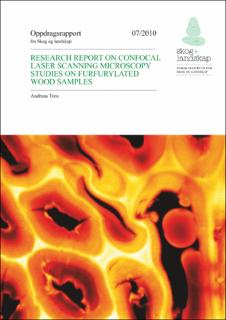| dc.contributor.author | Treu, Andreas | |
| dc.date.accessioned | 2022-02-15T08:36:15Z | |
| dc.date.available | 2022-02-15T08:36:15Z | |
| dc.date.created | 2022-02-14T10:26:57Z | |
| dc.date.issued | 2010 | |
| dc.identifier.uri | https://hdl.handle.net/11250/2978961 | |
| dc.description.abstract | Furfurylation of wood samples can lead to different outcome (different chemistry) and product properties depending on parameters such as pH-value, catalyst, amount of water, time and temperature. Changes in the furfurylation process can even lead to a deterioration of product performance, such as lower durability in comparison to other furfurylated products. How is it possible to detect these changes in chemistry of a furfurylated wood product? To answer this question confocal laser scanning microscopy was used. The expectation was to detect different emissions of the auto fluorescent furfuryl alcohol if differences in chemistry exist. Additionally to the differences in emitted wavelength, the area in the wood structure of different emissions was under investigation. It was the aim to detect whether different product performance of a furfurylated product or different furfurylation processes could be related to changes in chemistry and this was expected to be visualized by CLSM. | |
| dc.language.iso | eng | |
| dc.publisher | Norsk institutt for skog og landskap | |
| dc.relation.ispartof | Oppdragsrapport fra Skog og Landskap | |
| dc.relation.ispartofseries | Oppdragsrapport fra Skog og Landskap | |
| dc.title | Research report on confocal laser scanning microscopy studies on furfurylated wood samples | |
| dc.type | Research report | |
| dc.description.version | publishedVersion | |
| dc.source.pagenumber | 25 | |
| dc.source.issue | 07 | |
| dc.identifier.cristin | 2001177 | |
| cristin.ispublished | true | |
| cristin.fulltext | original | |
